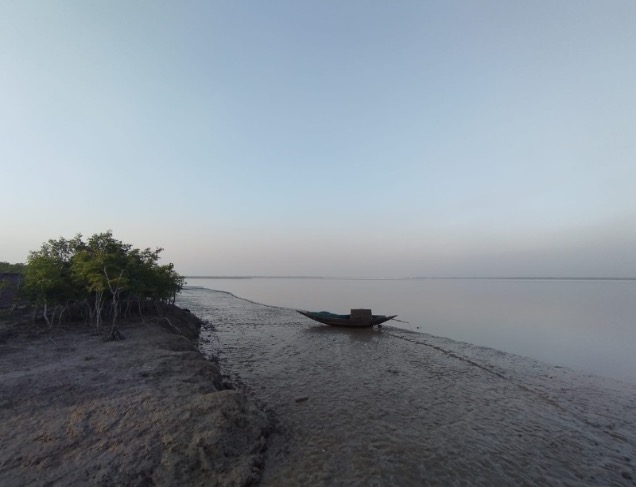Environment-Induced Mobilities: The Stories that the Field Tells

In Sundarban, India, my conversation with a Bangladeshi woman challenged the common perceptions surrounding environment-induced mobilities, since she cited insufficient income as the primary reason behind moving with her family. This made me look beyond the “obvious” during a six-month exploration using Feminist Participatory Action Research, revealing the interplay between environmental changes and migration decisions among Bangladeshi women who had moved to India.
In the rural areas of Sundarban, India, I engaged in a revealing conversation with a middle-aged woman who had moved from Bangladesh with her family. In response to my question about her decision to move to India, she replied: “To feed my family!” Intrigued, I asked further to understand the deeper challenges her family had faced in Bangladesh. The woman cited insufficient income as the main reason for them to move, but also how they once cultivated crops three times a year but were now constrained to the rainy season.
Having read about how environmental changes act as a primary factor of human mobilities in various academic literature and policy documents, I was somewhat taken aback by the response of my very first fieldwork participant. She did not cite environmental stressors as her primary push factors for moving to India and talked about the lack of employment opportunities. The more I interacted with the participants, the more I tried to understand their experiences from their own perspectives, setting aside my preconceived notions and existing knowledge, which allowed a clearer view of the challenges associated with analyzing environment-induced human mobilities.
Image showing Bidyadhari river in Sundarban, India captured by me during my fieldwork, September, 2023.
Stressors and Self-Perceptions
Conversations revolving around the theme of self-perceived stressors became common among the participants I spoke to over the following months. When I asked them about their reasons for moving to India, most of the women responded that they needed to feed their families. On further questioning, it became evident that the underlying reason was gradual and rapid onset environmental changes, in addition to gendered vulnerabilities that made it difficult for them to stick to the traditional sources of livelihood.
Guided by the insights of the first week’s discussions, the conversations took a different tone. Shifting my focus, I started to ask them about their daily routines, which prompted them to share the activities that define their lives – from fetching water and feeding cattle to growing vegetables, fishing, and a multitude of other activities that fill their days. It became clearer that everything they described, their lives and livelihoods, their “being” were intimately connected to environmental resources. This raised a compelling question, that is, as their origin and destination countries are both extremely vulnerable in the face of environmental stressors due to similar geographies, why did they not cite those as the primary push factors? Moreover, why did they move?
For them, the environment is such an integral part of their being that they do not think of it as a separate push factor. Despite facing a variety of shifts and stressors that have accelerated in recent years, these environmental challenges are relegated to the background. The immediate concern that takes precedence in their thoughts is feeding their families. Consequently, when deciding where to move, their most important consideration is whether employment opportunities exist, even if it causes them to give up their traditional sources of livelihoods.
On the Move
Talking about the variations in terms of environment-induced mobilities, most of the women or their families who crossed the borders are constantly on the move. For instance, some of the women moved with their families, some with the help of people who moved before them and others did so alone after their families had already shifted to India.
Their journeys, however, did not stop after crossing borders. Having lived in Sundarban, India and facing similar environmental and socio-economic challenges to those in Bangladesh once again, they move to the cities from the villages in Sundarban.
A few of them settle in the cities permanently and the rest travel on a daily, weekly, or even monthly basis for jobs. The women engage themselves in domestic work in most cases but sometimes they accompany the men of the family as construction workers too. Some move to other cities far away from their villages in search of better job opportunities.
Thus, post-migration, the expectations of finding alternative sources of income get shattered quite often and the uncertainties become exposed, causing many women and their families to continuously keep on moving in search of stability.
International is Also Local
While it is often argued that environment-induced mobilities are rarely found to be international, my fieldwork revealed a further nuance to it. All the women I interacted with had crossed an international border between India and Bangladesh, and some of them have done so irregularly involving huge risks. As they explained that the nearest city to them was in India and not in Bangladesh, they came to India with the hopes of leading a better life.
In addition to that, the cultural commonalities, historical ties, porous borders, and networks with other relatives, villagers, and family members who had already moved to India during different periods somewhat comforted them in making this decision to shift their lives to another country. For them, the political borders were not that significant in comparison to the emotional connection and established relations with a land that once was a part of their homeland.
Such interactions and experiences are memoirs of the nuances surrounding environment-induced mobilities. They point out the necessity of understanding the context-specific scenarios, hearing the first-hand experiences of those who are moving and the risks of over-simplifying and generalizing these mobilities. They keep reminding us that there is much more to every story than what is apparent and seems obvious.
*This blog post was inspired by a reflection on my six-month-long multi-sited fieldwork in Sundarban, India with the continuous support from the NGO – Goranbose Gram Bikash Kendra.
Mrittika Bhattacharya is a doctoral researcher in Sociology at the University of Bristol working on the intersections of environment, gender and mobilities in the Indo-Bangladesh region.



